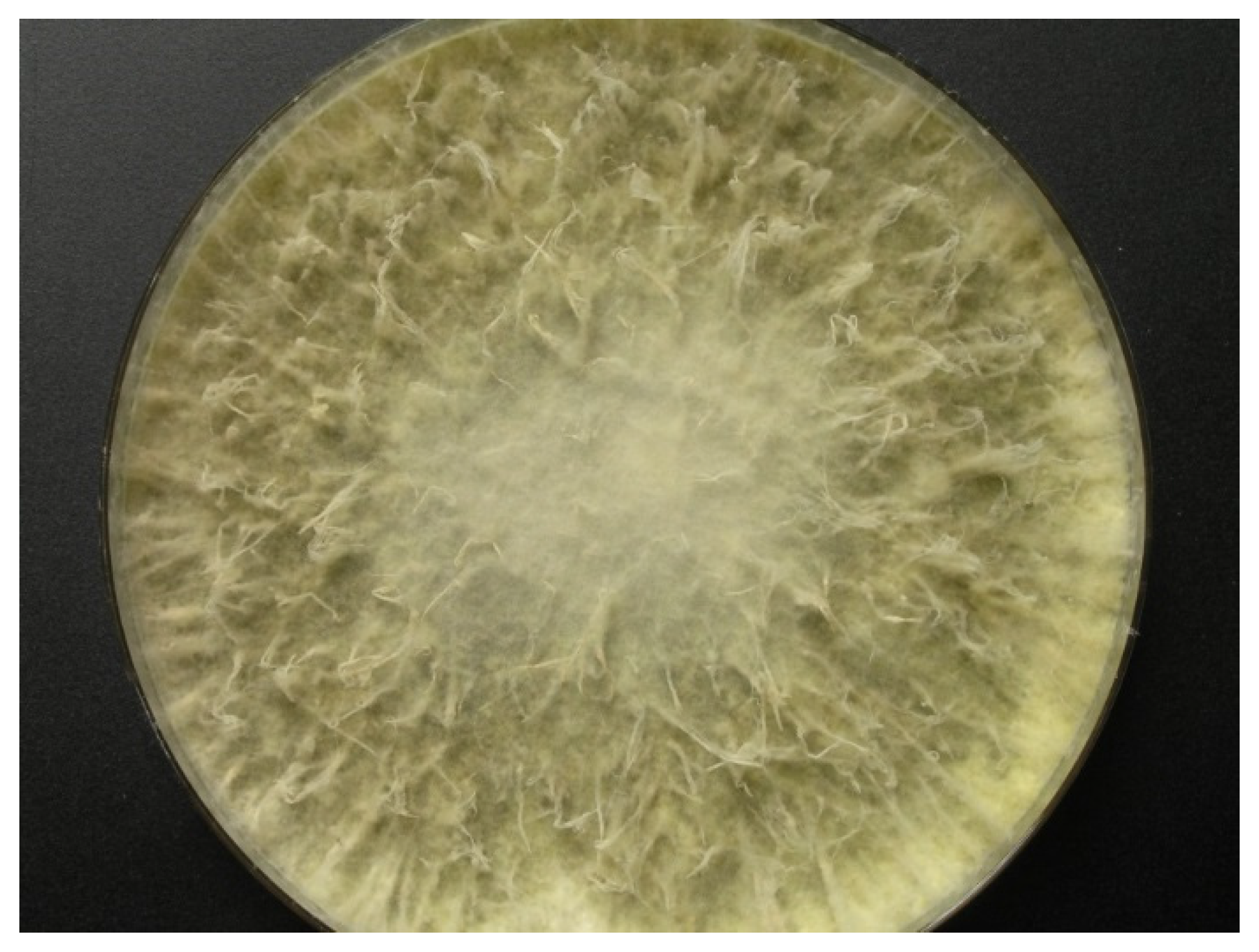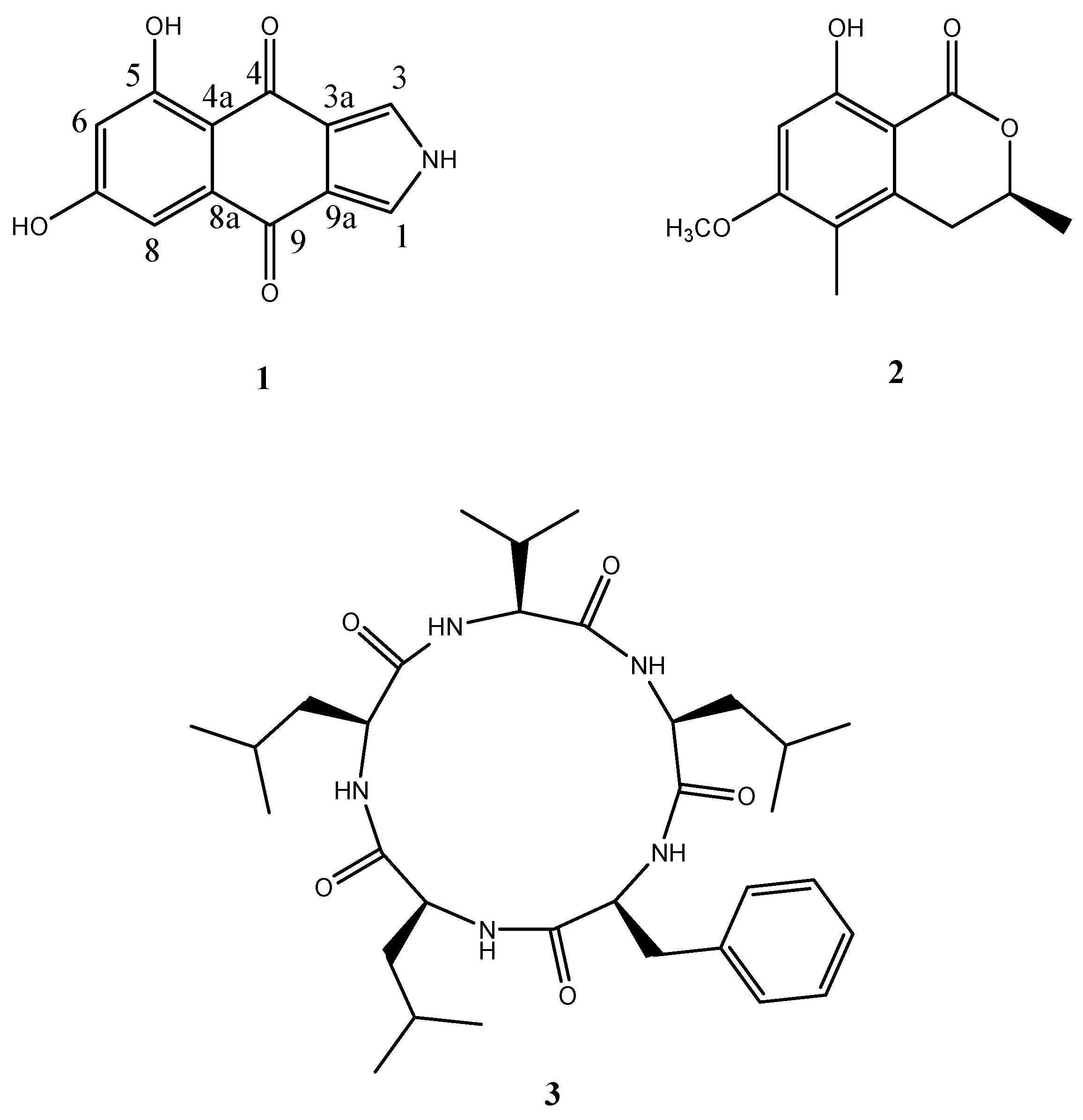Biscogniauxone, a New Isopyrrolonaphthoquinone Compound from the Fungus Biscogniauxia mediterranea Isolated from Deep-Sea Sediments †
Abstract
:1. Introduction
2. Results
2.1. Sampling, Isolation, and Identification of Strain LF657
2.2. Structural Elucidation
2.3. Biological Activities
3. Discussion
4. Experimental Section
4.1. General Experimental Procedures
4.2. Isolation, Cultivation, and Storage of the Producer Strain LF657
4.3. Identification of the Strain LF657
4.4. Fermentation and Production of Extracts for the Purification of Compound 1, 2, 3
4.5. Extraction and Isolation of Compounds 1
4.6. Biological Activities Assays
5. Conclusions
Supplementary Materials
Acknowledgments
Author Contributions
Conflicts of Interest
References
- Skropeta, D. Deep-sea natural products. Nat. Prod. Rep. 2008, 25, 1131–1166. [Google Scholar] [CrossRef] [PubMed]
- Skropeta, D.; Wei, L.Q. Recent advances in deep-sea natural products. Nat. Prod. Rep. 2014, 31, 999–1025. [Google Scholar] [CrossRef] [PubMed]
- Wiese, J.; Ohlendorf, B.; Blümel, M.; Schmaljohann, R.; Imhoff, J.F. Phylogenetic identification of fungi isolated from the marine sponge Tethya aurantium and identification of their secondary metabolites. Mar. Drugs 2011, 9, 561–585. [Google Scholar] [CrossRef] [PubMed]
- Imhoff, J.F. Natural products from marine fungi—Still an underrepresented resource. Mar. Drugs 2016, 14, 19. [Google Scholar] [CrossRef] [PubMed] [Green Version]
- Piggott, M.J. Naphtho[2,3-c]furan-4,9-diones and related compounds: Theoretically interesting and bioactive natural and synthetic products. Tetrahedron 2005, 61, 9929–9954. [Google Scholar] [CrossRef]
- Kuntze, O. Revisio Generum Plantarum 2; A. Felix: Leipzig, Germany, 1891; p. 398. [Google Scholar]
- Peláez, F.; González, V.; Platas, G.; Sánchez-Ballesteros, J.; Rubio, V. Molecular phylogenetic studies within the Xylariaceae based on ribosomal DNA sequences. Fungal Divers. 2008, 31, 111–134. [Google Scholar]
- Tang, A.M.C.; Jeewon, R.; Hyde, K.D. A re-evaluation of the evolutionary relationships within the Xylariaceae based on ribosomal and protein-coding gene sequences. Fungal Divers. 2009, 34, 127–155. [Google Scholar]
- De Alvarenga, M.A.; Fo, R.B.; Gottlieb, O.R.; Dias, J.P.P.; Magalhães, A.F.; Magalhães, E.G.; de Magalhães, G.C.; Magalhães, M.T.; Maia, J.G.S.; Marques, R.; et al. Dihydroisocoumarins and phthalide from wood samples infested by fungi. Phytochemistry 1978, 17, 515–516. [Google Scholar] [CrossRef]
- Liu, S.; Gu, W.; Lo, D.; Ding, X.-Z.; Ujiki, M.; Adrian, T.E.; Soff, G.; Silverman, R.B. N-methylsansalvamide A peptide analogues. Potent new antitumor agents. J. Med. Chem. 2005, 48, 3630–3638. [Google Scholar] [CrossRef] [PubMed]
- Belofsky, G.N.; Jensen, P.R.; Fenical, W. Sansalvamide: A new cytotoxic cyclic depsipeptide produced by a marine fungus of the genus. Fusarium Tetrahedron Lett. 1999, 40, 2913–2916. [Google Scholar] [CrossRef]
- Stipanovic, R.D.; Zhang, J.; Bruton, B.D.; Wheeler, M.H. Isolation and identification of hexaketides from a pigmented Monosporascus cannonballus isolate. J. Agric. Food Chem. 2004, 52, 4109–4112. [Google Scholar] [CrossRef] [PubMed]
- Fotso, S.; Maskey, R.P.; Gruen-Wollny, I.; Schulz, K.-P.; Munk, M.; Laatsch, H. Bhimamycin A to approximately E and bhimanone: Isolation, structure elucidation and biological activity of novel quinone antibiotics from a terrestrial streptomycete. J. Antibiot. 2003, 56, 931–941. [Google Scholar] [CrossRef] [PubMed]
- Jetter, P.; Steinert, C.; Knauer, M.; Zhang, G.; Bruhn, T.; Wiese, J.; Imhoff, J.F.; Fiedler, H.-P.; Bringmann, G. New bhimamycins from Streptomyces sp. AK 671. J. Antibiot. 2013, 66, 719–725. [Google Scholar] [CrossRef] [PubMed]
- Evidente, A.; Andolfi, A.; Maddau, L.; Franceschini, A.; Marras, F. Biscopyran, a phytotoxic hexasubstituted pyranopyran produced by Biscogniauxia mediterranea, a fungus pathogen of cork oak. J. Nat. Prod. 2005, 68, 568–571. [Google Scholar] [CrossRef] [PubMed]
- Cheng, M.-J.; Wu, M.-D.; Yanai, H.; Su, Y.-S.; Chen, I.-S.; Yuan, G.-F.; Hsieh, S.-Y.; Chen, J.-J. Secondary metabolites from the endophytic fungus Biscogniauxia formosana and their antimycobacterial activity. Phytochem. Lett. 2012, 5, 467–472. [Google Scholar] [CrossRef]
- Raja, H.A.; Kaur, A.; El-Elimat, T.; Figueroa, M.; Kumar, R.; Deep, G.; Agarwal, R.; Faeth, S.H.; Cech, N.B.; Oberlies, N.H. Phylogenetic and chemical diversity of fungal endophytes isolated from Silybum marianum (L) Gaertn. (milk thistle). Mycology 2015, 6, 8–27. [Google Scholar] [CrossRef] [PubMed]
- Amand, S.; Langenfeld, A.; Blond, A.; Dupont, J.; Nay, B.; Prado, S. Guaiane sesquiterpenes from Biscogniauxia nummularia featuring potent antigerminative activity. J. Nat. Prod. 2012, 27, 798–801. [Google Scholar] [CrossRef] [PubMed]
- Kim, K.M.; Lee, K.S.; Lee, G.Y.; Jin, H.; Durrance, E.S.; Park, H.S.; Choi, S.H.; Park, K.S.; Kim, Y.B.; Jang, H.C.; et al. Anti-diabetic efficacy of KICG1338, a novel glycogen synthase kinase-3β inhibitor, and its molecular characterization in animal models of type 2 diabetes and insulin resistance. Mol. Cell Endocrinol. 2015, 409, 1–10. [Google Scholar] [CrossRef] [PubMed]
- Bhat, R.V.; Haeberlein, S.L.B.; Avila, J. Glycogen synthase kinase 3: A drug target for CNS therapies. J. Neurochem. 2004, 89, 1313–1317. [Google Scholar] [CrossRef] [PubMed]
- McCubrey, J.A.; Steelman, L.S.; Bertrand, F.E.; Davis, N.M.; Sokolosky, M.; Abrams, S.L.; Montalto, G.; D’Assoro, A.B.; Libra, M.; Nicoletti, F.; et al. GSK-3 as potential target for therapeutic intervention in cancer. Oncotarget 2014, 5, 2881–2911. [Google Scholar] [CrossRef] [PubMed]
- Sellers, R.P.; Alexander, L.D.; Johnson, V.A.; Lin, C.-C.; Savage, J.; Corral, R.; Moss, J.; Slugocki, T.S.; Singh, E.K.; Davis, M.R.; et al. Design and synthesis of Hsp90 inhibitors: Exploring the SAR of sansalvamide A derivatives. Bioorg. Med. Chem. 2010, 18, 6822–6856. [Google Scholar] [CrossRef] [PubMed]
- Gärtner, A.; Blümel, M.; Wiese, J.; Imhoff, J.F. Isolation and characterisation of bacteria from the Eastern Mediterranean deep sea. Antonie Van Leeuwenhoek 2011, 100, 421–435. [Google Scholar] [CrossRef] [PubMed]
- Wickerham, L.J. Taxonomy of Yeasts; Technical Bulletin No. 1029; United States Department of Agriculture: Washington, DC, USA, 1951.
- Wu, B.; Wiese, J.; Labes, A.; Kramer, A.; Schmaljohann, R.; Imhoff, J.F. Lindgomycin, an unusual antibiotic polyketide from a marine fungus of the Lindgomycetaceae. Mar. Drugs 2015, 13, 4617–4632. [Google Scholar] [CrossRef] [PubMed]
- White, T.J.; Bruns, T.; Lee, S.; Taylor, J.W. Amplification and direct sequencing of fungal ribosomal RNA genes for phylogenetics. In PCR Protocols: A Guide to Methods and Applications; Innis, M.A., Gelfand, D.H., Sninsky, J.J., White, T.J., Eds.; Academic Press: New York, NY, USA, 1990; pp. 315–322. [Google Scholar]
- Vilgalys, R.; Hester, M. Rapid genetic identification and mapping of enzymatically amplified ribosomal DNA from several Cryptococcus species. J. Bacteriol. 1990, 172, 4238–4246. [Google Scholar] [PubMed]
- Vilgalys, R. Conserved Primer Sequences for PCR Amplification and Sequencing from Nuclear Ribosomal RNA. Available online: http://www.botany.duke.edu/fungi/mycolab (accessed on 22 June 2015).
- Altschul, S.F.; Gish, W.; Miller, W.; Myers, E.W.; Lipman, D.J. Basic local alignment search tool. J. Mol. Biol. 1990, 215, 403–410. [Google Scholar] [CrossRef]
- Tatsuova, T.; Madden, T.L. Blast 2 sequences—A new tool for comparing protein and nucleotide sequences. FEMS Microbiol. Lett. 1999, 174, 247–250. [Google Scholar] [CrossRef]
- Ohlendorf, B.; Schulz, D.; Erhard, A.; Nagel, K.; Imhoff, J.F. Geranylphenazinediol, an acetylcholinesterase inhibitor produced by a Streptomyces species. J. Nat. Prod. 2012, 75, 1400–1404. [Google Scholar] [CrossRef] [PubMed]
- Silber, J.; Ohlendorf, B.; Labes, A.; Erhard, A.; Imhoff, J.F. Calcarides A–E, antibacterial macrocyclic and linear polyesters from a Calcarisporium strain. Mar. Drugs 2013, 11, 3309–3323. [Google Scholar] [CrossRef] [PubMed]
- Jansen, N.; Ohlendorf, B.; Erhard, A.; Imhoff, J.F. Helicusin E, Isochromophilone X and isochromophilone XI: New chloroazaphilones produced by the fungus Bartalinia robillardoides strain LF550. Mar. Drugs 2013, 11, 800–816. [Google Scholar] [CrossRef] [PubMed] [Green Version]
- Baki, A.; Bielik, A.; Molnar, L.; Szendrei, G.; Keserü, G.M. A high through-put luminsescent assay for glycogen synthase kinase-3 beta inhibitors. Assay Drug Dev. Technol. 2007, 5, 75–83. [Google Scholar]
- Schulz, D.; Beese, P.; Ohlendorf, B.; Erhard, A.; Zinecker, H.; Dorador, C.; Imhoff, J.F. Abenquines A–D: Aminoquinone derivatives produced by Streptomyces sp. strain DB634. J. Antibiot. 2011, 64, 763–768. [Google Scholar] [CrossRef] [PubMed]
- Silber, J.; Ohlendorf, B.; Labes, A.; Näther, C.; Imhoff, J.F. Calcaripeptides A−C, cyclodepsipeptides from a Calcarisporium strain. J. Nat. Prod. 2013, 76, 1461–1467. [Google Scholar] [CrossRef] [PubMed]



| Position | δC a,b | δH c Mult. (J in Hz) | HMBC d |
|---|---|---|---|
| 1 | 123.9, CH | 7.70, overlap, dd (3.1, 1.6) | 3, 9a, 9 |
| 3 | 124.4, C | ||
| 3a | 121.6 e, CH | 7.70, overlap, dd (3.1, 1.6) | 1, 3a, 4, 9a |
| 4 | 185.2, C | ||
| 4a | 110.8, C | ||
| 5 | 165.4, C | ||
| 6 | 107.3, CH | 6.47, d (2.4) | 4a, 5 |
| 7 | 165.4, C | ||
| 8 | 108.4, CH | 7.06, d (2.4) | 7, 8a, 9 |
| 8a | 138.2, C | ||
| 9 | 179.1, C | ||
| 9a | 122.0 e, C | ||
| 5-OH | 13.27, s |
© 2016 by the authors; licensee MDPI, Basel, Switzerland. This article is an open access article distributed under the terms and conditions of the Creative Commons Attribution (CC-BY) license (http://creativecommons.org/licenses/by/4.0/).
Share and Cite
Wu, B.; Wiese, J.; Schmaljohann, R.; Imhoff, J.F. Biscogniauxone, a New Isopyrrolonaphthoquinone Compound from the Fungus Biscogniauxia mediterranea Isolated from Deep-Sea Sediments. Mar. Drugs 2016, 14, 204. https://doi.org/10.3390/md14110204
Wu B, Wiese J, Schmaljohann R, Imhoff JF. Biscogniauxone, a New Isopyrrolonaphthoquinone Compound from the Fungus Biscogniauxia mediterranea Isolated from Deep-Sea Sediments. Marine Drugs. 2016; 14(11):204. https://doi.org/10.3390/md14110204
Chicago/Turabian StyleWu, Bin, Jutta Wiese, Rolf Schmaljohann, and Johannes F. Imhoff. 2016. "Biscogniauxone, a New Isopyrrolonaphthoquinone Compound from the Fungus Biscogniauxia mediterranea Isolated from Deep-Sea Sediments" Marine Drugs 14, no. 11: 204. https://doi.org/10.3390/md14110204
APA StyleWu, B., Wiese, J., Schmaljohann, R., & Imhoff, J. F. (2016). Biscogniauxone, a New Isopyrrolonaphthoquinone Compound from the Fungus Biscogniauxia mediterranea Isolated from Deep-Sea Sediments. Marine Drugs, 14(11), 204. https://doi.org/10.3390/md14110204








